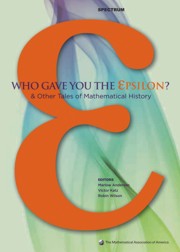Book contents
- Frontmatter
- Introduction
- Contents
- Analysis
- Geometry, Topology and Foundations
- Foreword
- Gauss and the Non-Euclidean Geometry
- History of the Parallel Postulate
- The Rise and Fall of Projective Geometry
- Notes on the History of Geometrical Ideas
- A note on the history of the Cantor set and Cantor function
- Evolution of the Topological Concept of “Connected”
- A Brief, Subjective History of Homology and Homotopy Theory in this Century
- The Origins of Modern Axiomatics: Pasch to Peano
- C. S. Peirce's Philosophy of Infinite Sets
- On the Development of Logics between the two World Wars
- Dedekind's Theorem:√2 × √3 = √6
- Afterword
- Algebra and Number Theory
- Surveys
- Index
- About the Editors
History of the Parallel Postulate
from Geometry, Topology and Foundations
- Frontmatter
- Introduction
- Contents
- Analysis
- Geometry, Topology and Foundations
- Foreword
- Gauss and the Non-Euclidean Geometry
- History of the Parallel Postulate
- The Rise and Fall of Projective Geometry
- Notes on the History of Geometrical Ideas
- A note on the history of the Cantor set and Cantor function
- Evolution of the Topological Concept of “Connected”
- A Brief, Subjective History of Homology and Homotopy Theory in this Century
- The Origins of Modern Axiomatics: Pasch to Peano
- C. S. Peirce's Philosophy of Infinite Sets
- On the Development of Logics between the two World Wars
- Dedekind's Theorem:√2 × √3 = √6
- Afterword
- Algebra and Number Theory
- Surveys
- Index
- About the Editors
Summary
Like the famous problems of construction, Euclid's postulate concerning parallels is a thought that links the ages. Its history is a long story with a dramatic climax and far-reaching in?uence on modern mathematical and general scientific thought. I wish to recall briefly the salient features of the story, and to state what seem to me its suggestions in regard to the teaching of elementary geometry.
Euclid's fifth postulate (called also the eleventh or twelfth axiom) states: “If a straight line falling on two straight lines makes the interior angles on the same side less than two right angles, the two straight lines if produced indefinitely meet on that side on which are the angles less than two right angles” [2]. The earliest commentators found fault with this statement as being not self-evident. Concerning the meaning of axiom, Aristotle says: “That which it is necessary for anyone to hold who is to learn anything at all is an axiom”; and “It is ignorance alone that could lead anyone to try to prove the axiom.” Without going into the difficult question of the precise distinction to the Greek mind between axiom and postulate, we may take it that the character of being indisputable pertained to each. Postulates stating that a straight line joining any two points can be drawn, that a circle can be drawn with given center and radius, or that all right angles are equal, were accepted, while the postulate of parallels was scrutinized and admitted at best with reluctance.
- Type
- Chapter
- Information
- Who Gave You the Epsilon?And Other Tales of Mathematical History, pp. 120 - 124Publisher: Mathematical Association of AmericaPrint publication year: 2009

